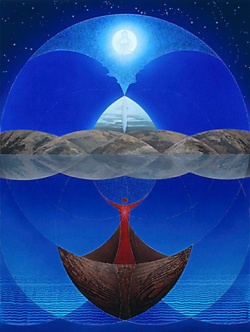Difference between revisions of "Nakshatra"
(Redirected page to Twenty-eight constellations) |
|||
| (3 intermediate revisions by the same user not shown) | |||
| Line 1: | Line 1: | ||
| − | + | {{DisplayImages|697}} | |
| + | [[Nakshatra]] ({{Wiki|Devanagari}}: {{SanskritBig|[[नक्षत्र]]}} [[nákṣatra]]) is the term for {{Wiki|lunar mansion}} in {{Wiki|Hindu astrology}}. A [[nakshatra]] is one of 27 (sometimes also 28) sectors along the {{Wiki|ecliptic}}. Their names are related to the most prominent asterisms in the respective sectors. | ||
| + | |||
| + | The starting point for the [[nakshatras]] is the point on the {{Wiki|ecliptic}} directly opposite to the {{Wiki|star}} {{Wiki|Spica}} called [[Wikipedia:Nakshatra|Chitrā]] in [[Sanskrit]] (other slightly different definitions [[exist]]). It is called [[Meshādi]] or the "start of [[Aries]]". The {{Wiki|ecliptic}} is divided into each of the [[nakshatras]] eastwards starting from this point. The number of [[nakshatras]] reflects the number of days in a sidereal month ({{Wiki|modern}} value: 27.32 days), that the width of a [[nakshatra]] is traversed by the [[moon]] in about one day. Each [[nakshatra]] is further subdivided into quarters (or [[padas]]) These play a role in popular {{Wiki|Hindu astrology}}, where each pada is associated with a {{Wiki|syllable}}, {{Wiki|conventionally}} chosen as the first {{Wiki|syllable}} of the given [[name]] of a child born when the [[moon]] was in the corresponding pada. | ||
| + | |||
| + | The [[nakshatras]] of [[traditional]] [[Hindu]] {{Wiki|astronomy}} are based on a list of 28 asterisms found in the {{Wiki|Atharvaveda}} (AVŚ 19.7) and also in the Shatapatha [[Brahmana]]. The first astronomical text that lists them is the {{Wiki|Vedanga Jyotisha}}. | ||
| + | |||
| + | In classical [[Hindu]] [[mythology]] ([[Mahabharata]], {{Wiki|Harivamsa}}), the creation of the [[nakshatras]] is attributed to [[Daksha]]. They are personified as daughters of the [[deity]] and as [[mythological]] wives of [[Chandra]], the [[moon god]], or alternatively the daughters of [[Kashyapa]], the brother of [[Daksha]]. | ||
| + | |||
| + | Each of the [[nakshatras]] is governed as '[[lord]]' by one of the nine {{Wiki|graha}} in the following sequence: [[Wikipedia:Ketu (mythology)|Ketu]] ([[South]] [[Lunar Node]]), {{Wiki|Shukra}} ({{Wiki|Venus}}), [[Ravi]] or [[Surya]] ({{Wiki|Sun}}), [[Chandra]] ([[Moon]]), [[Mangala]] ({{Wiki|Mars}}), [[Rahu]] ([[North]] [[Lunar Node]]), [[Guru]] or [[Brihaspati]] ({{Wiki|Jupiter}}), {{Wiki|Shani}} ({{Wiki|Saturn}}) and [[Budha]] ({{Wiki|Mercury}}). This cycle repeats itself three times to cover all 27 [[nakshatras]]. The [[lord]] of each [[nakshatra]] determines the {{Wiki|planetary}} period known as the [[dasha]], which is considered of major importance in forecasting the [[life]] [[path]] of the {{Wiki|individual}} in {{Wiki|Hindu astrology}}. | ||
| + | |||
| + | In {{Wiki|Vedic Sanskrit}}, the term nákṣatra may refer to any [[heavenly]] [[body]], or to "the {{Wiki|stars}}" collectively. The classical [[sense]] of "{{Wiki|lunar mansion}}" is first found in the {{Wiki|Atharvaveda}}, and becomes the primary meaning of the term in {{Wiki|Classical Sanskrit}}. | ||
| + | {{W}} | ||
| + | |||
| + | {{SeeAtEnd|Twenty-eight constellations}} | ||
| + | [[Category:Astrology]] | ||
{{SanskritTerminology}} | {{SanskritTerminology}} | ||
Latest revision as of 17:02, 14 July 2014
Nakshatra (Devanagari: नक्षत्र nákṣatra) is the term for lunar mansion in Hindu astrology. A nakshatra is one of 27 (sometimes also 28) sectors along the ecliptic. Their names are related to the most prominent asterisms in the respective sectors.
The starting point for the nakshatras is the point on the ecliptic directly opposite to the star Spica called Chitrā in Sanskrit (other slightly different definitions exist). It is called Meshādi or the "start of Aries". The ecliptic is divided into each of the nakshatras eastwards starting from this point. The number of nakshatras reflects the number of days in a sidereal month (modern value: 27.32 days), that the width of a nakshatra is traversed by the moon in about one day. Each nakshatra is further subdivided into quarters (or padas) These play a role in popular Hindu astrology, where each pada is associated with a syllable, conventionally chosen as the first syllable of the given name of a child born when the moon was in the corresponding pada.
The nakshatras of traditional Hindu astronomy are based on a list of 28 asterisms found in the Atharvaveda (AVŚ 19.7) and also in the Shatapatha Brahmana. The first astronomical text that lists them is the Vedanga Jyotisha.
In classical Hindu mythology (Mahabharata, Harivamsa), the creation of the nakshatras is attributed to Daksha. They are personified as daughters of the deity and as mythological wives of Chandra, the moon god, or alternatively the daughters of Kashyapa, the brother of Daksha.
Each of the nakshatras is governed as 'lord' by one of the nine graha in the following sequence: Ketu (South Lunar Node), Shukra (Venus), Ravi or Surya (Sun), Chandra (Moon), Mangala (Mars), Rahu (North Lunar Node), Guru or Brihaspati (Jupiter), Shani (Saturn) and Budha (Mercury). This cycle repeats itself three times to cover all 27 nakshatras. The lord of each nakshatra determines the planetary period known as the dasha, which is considered of major importance in forecasting the life path of the individual in Hindu astrology.
In Vedic Sanskrit, the term nákṣatra may refer to any heavenly body, or to "the stars" collectively. The classical sense of "lunar mansion" is first found in the Atharvaveda, and becomes the primary meaning of the term in Classical Sanskrit.
